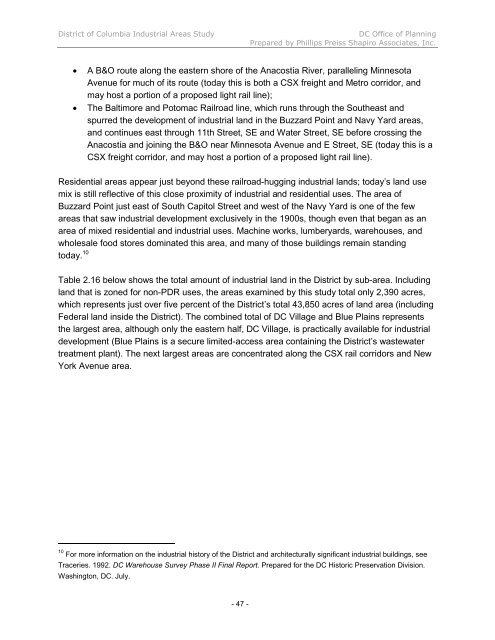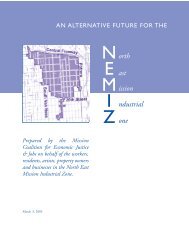INDUSTRIAL LAND IN A POST-INDUSTRIAL CITY District of ...
INDUSTRIAL LAND IN A POST-INDUSTRIAL CITY District of ...
INDUSTRIAL LAND IN A POST-INDUSTRIAL CITY District of ...
You also want an ePaper? Increase the reach of your titles
YUMPU automatically turns print PDFs into web optimized ePapers that Google loves.
<strong>District</strong> <strong>of</strong> Columbia Industrial Areas Study DC Office <strong>of</strong> Planning<br />
Prepared by Phillips Preiss Shapiro Associates, Inc.<br />
A B&O route along the eastern shore <strong>of</strong> the Anacostia River, paralleling Minnesota<br />
Avenue for much <strong>of</strong> its route (today this is both a CSX freight and Metro corridor, and<br />
may host a portion <strong>of</strong> a proposed light rail line);<br />
The Baltimore and Potomac Railroad line, which runs through the Southeast and<br />
spurred the development <strong>of</strong> industrial land in the Buzzard Point and Navy Yard areas,<br />
and continues east through 11th Street, SE and Water Street, SE before crossing the<br />
Anacostia and joining the B&O near Minnesota Avenue and E Street, SE (today this is a<br />
CSX freight corridor, and may host a portion <strong>of</strong> a proposed light rail line).<br />
Residential areas appear just beyond these railroad-hugging industrial lands; today’s land use<br />
mix is still reflective <strong>of</strong> this close proximity <strong>of</strong> industrial and residential uses. The area <strong>of</strong><br />
Buzzard Point just east <strong>of</strong> South Capitol Street and west <strong>of</strong> the Navy Yard is one <strong>of</strong> the few<br />
areas that saw industrial development exclusively in the 1900s, though even that began as an<br />
area <strong>of</strong> mixed residential and industrial uses. Machine works, lumberyards, warehouses, and<br />
wholesale food stores dominated this area, and many <strong>of</strong> those buildings remain standing<br />
today. 10<br />
Table 2.16 below shows the total amount <strong>of</strong> industrial land in the <strong>District</strong> by sub-area. Including<br />
land that is zoned for non-PDR uses, the areas examined by this study total only 2,390 acres,<br />
which represents just over five percent <strong>of</strong> the <strong>District</strong>’s total 43,850 acres <strong>of</strong> land area (including<br />
Federal land inside the <strong>District</strong>). The combined total <strong>of</strong> DC Village and Blue Plains represents<br />
the largest area, although only the eastern half, DC Village, is practically available for industrial<br />
development (Blue Plains is a secure limited-access area containing the <strong>District</strong>’s wastewater<br />
treatment plant). The next largest areas are concentrated along the CSX rail corridors and New<br />
York Avenue area.<br />
10 For more information on the industrial history <strong>of</strong> the <strong>District</strong> and architecturally significant industrial buildings, see<br />
Traceries. 1992. DC Warehouse Survey Phase II Final Report. Prepared for the DC Historic Preservation Division.<br />
Washington, DC. July.<br />
- 47 -












